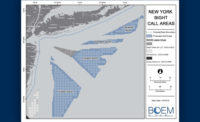Clean Energy
East Coast Offshore Wind Projects Push Forward to Make Up for Past Delays

South Brooklyn Marine Terminal in Brooklyn, NY, here pictured in 2022 rendering —which will support Equinor's Empire 1 54-turbine offshore wind energy project— broke ground on June 10.
Image: Courtesy of Equinor
This story has been updated to reflect new information on the Arthur Kill Terminal wind port in Staten Island.
New York officials last month finalized power purchase deals with offshore wind developers Equinor and Orsted for the 810-MW Empire Wind 1 and 924-MW Sunrise Wind, their respective state projects that are both set to operate in 2026.The firms were awarded conditional contracts in a February rebid at higher offtake prices after being cancelled in recent months. The state grid operator also extended to June 17 a deadline for proposed transmission connections into the New York City grid for multiple state wind projects totaling about 5 GW.
In New Jersey, Orsted has agreed to pay the state a $125-million penalty for cancelling last year two offshore wind projects totaling 2.25 GW, with the firm citing increased development costs and local opposition. But it is set to bid about 2.6GW in a just announced fifth procurement round—now to start in second quarter 2025 instead of the originally announced third quarter 2026, the state said.
The U.S. Interior Dept. also issued on May 29 its final environmental review for the first 1.5-GW phase of the Atlantic Shores Wind project in New Jersey, which could gain full construction start approval on July 1, the agency said. Developers Shell and EDF announced they had hired state contractors J. Fletcher Creamer & Son and Jingoli to develop infrastructure for the project's on-shore grid connections, with cables set to come ashore in Atlantic City and Sea Girt.
Expanded Development
Interior also said on June 6 that it released its final environmental review of a new Atlantic Ocean tract between Delaware and North Carolina, totaling hundreds of thousands of acres, for potential offshore wind development, "with a finding of no significant impact." The finding could open some tract areas for upcoming federal lease sales, the agency said, with no dates noted but market speculation they could start this year. Those sales also may include one tract that would require floating wind development, with ocean depth up to 148 meters, the agency said.
Interior Secretary Deb Haaland announced in April lease sales over the next five years, including four "potential" in 2024 in the Central Atlantic, Gulf of Maine, Gulf of Mexico, and Oregon; with one each in 2025 and 2026 in the Gulf of Mexico and Central Atlantic; two in 2027 in the Gulf and NY Bight; and four in 2028, in California, a U.S.Territory, Gulf of Maine, and Hawaii.
Equinor said it broke ground June 10 on construction of the South Brooklyn Marine Terminal in Brooklyn, N.Y., which is set as the base for Empire Wind 1 construction and operation, and is envisioned as "a hub for offshore wind on the East Coast," the firm noted in a statement. The 73-acre site, being developed by Skanska under an estimated $861 million contract with a project labor agreement, "will be one of the largest dedicated offshore wind hubs in the United States, designed to accommodate future projects," Equinor said.
Also moving forward is the Arthur Kill Terminal in Staten Island, a privately funded offshore wind marshalling and assembly port that developer Atlantic Offshore Terminals said has won city planning commission approval. The 32.5-acre facility, to be built on a greenfield site south of the Outerbridge Crossing, is set for completion in 2027.
Boone Davis, CEO of the developer, says the facility, now set for city council review, is designed for staging, assembly and pre-commissioning of offshore wind turbine generators to be installed at offshore wind farms in the New York Bight and elsewhere along the East Coast. He said the facility site offers "logistics advantages," as the only port in New York Harbor that is not subject to air draft restrictions for moving large turbine components and can support the full range of offshore wind installation vessels and construction methods.
Davis did not confirm project cost, but Atlantic Offshore Terminals had earlier disclosed an estimated $350 million price for the terminal. It has also received $48 million from the U.S. Maritime Administration and seeks other government grants, Mueser Rutledge Consulting Engineers and T. LaPorta Architect will handle site design and engineering, with construction contracts to be awarded "in the coming months," said Davis, although he did not specify when construction would start.
“There is a very substantial amount of offshore wind energy capacity to constructed in the New York Bight region in the coming decades, and New York’s and New Jersey’s support has not wavered despite macroeconomic challenges,” Davis told ENR, noting the ocean area between the two states "as having one of the largest concentrations of offshore wind energy [capacity] in the country.”
New York has a mandate to install 9GW of offshore wind capacity by 2035 and New Jersey aims to have 11GW by 2040.





